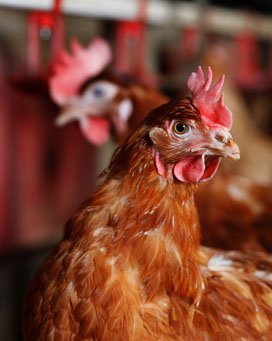Downstream investments increases power of genetics companies

An increasing number of commercial hatcheries follow the downstream investments of some leading layer and broiler breeding companies with mistrust. They fear for their future and the power these genetics companies may (mis-)use over the production and distribution of commercial layers or broilers.
By Wiebe van der Sluis
The dramatic reduction in the number of poultry genetics companies around the world witnessed over the past 20 years created a situation in which a few companies control the majority of the world meat and egg breeder market. In the layer business we basically recognise two major genetics companies offering a limited number of products under different trade names. This worries many people.
Besides a reduction in genetic potential, genetic gene pools and genetic variability there is a possible loss in creativity in how to respond to challenges of future markets. In addition the growing power of these few remaining companies may lead to monopolistic behaviour in some markets, which often results in a loss of independency of existing hatcheries and in significantly higher prices. In some countries we already witness a monopolistic structure which resulted in an up to three or four times higher price for parent (PS) and grandparent stock (GPS) compared to those where more breeding companies still hold a certain market share.
Securing income
Traditionally genetics companies made use of independent distributers who most of the time kept GPS or PS stock to serve their clients. These distributors often offered different brands, which allowed them to meet the diverse demand of the local market. The diminution in poultry genetics companies went with a reduction in product variety and therefore increased the number of flocks of one or two brands. Consequently the volume increase made negotiations between the genetics company and distributors tougher and both parties became more demanding. This is especially the case in the table egg layer market.
Traditionally genetics companies made use of independent distributers who most of the time kept GPS or PS stock to serve their clients. These distributors often offered different brands, which allowed them to meet the diverse demand of the local market. The diminution in poultry genetics companies went with a reduction in product variety and therefore increased the number of flocks of one or two brands. Consequently the volume increase made negotiations between the genetics company and distributors tougher and both parties became more demanding. This is especially the case in the table egg layer market.
Meanwhile as a result of genetic improvements (more eggs and meat produced per PS) genetics companies witnessed that the expanding consumer market did not result in an equal growth in demand for GPS and PS. They realised that when charging the same price for PS as they did before would ultimately put a heavy burden on their financial stability and could lead to their own destruction. At the same time genetics companies, striving to stay ahead of the competition, are facing higher costs for R&D. These costs have to be covered through increasing the price for their products since increasing sales is limited.
Controlling distribution
Egg producers, being forced by supermarket chains to keep the egg price low, had to expand their operations to generate a fair return on investments and income. The resulting increase in production made the market very volatile. The balance between profit and loss time became uneven, making the future even more insecure for all parties.
Egg producers, being forced by supermarket chains to keep the egg price low, had to expand their operations to generate a fair return on investments and income. The resulting increase in production made the market very volatile. The balance between profit and loss time became uneven, making the future even more insecure for all parties.
The USA based genetics company Hy-Line knows what it means to be active in egg production. Some 35 years ago the company was not too successful in the production of commercial eggs. At that time Dr. Dennis Casey became their new president. He brought the company back to its core business, but also bought up most of the facilities of Hy-Line’s own major distributors and turned them into a nationwide company owned distribution system. Casey realised that the real money was in the sale of commercial chicks at high volume by demand. Vertical integration allowed him to reduce the transaction costs between production stages as well as to increase the quality of end products through greater coordination between stages.
The control over crucial stages and dominating a large part of the US market also created the possibility for Hy-Line to balance supply and demand. When egg production forecasts were beyond demand the supply of layers simply could be reduced and consequently at time the number of marketable eggs in order to assure a fair price for the eggs produced. This kept the producers satisfied and prepared to pay the required price for pullets.
Using distributors
With these thoughts in mind one could be in favour of the current trend in downstream investments by some major poultry genetics companies. The problem however is that this model only works when all parties equally participate and favour the advantages. Regrettably company strategies are not driven by the noble thought of equal sharing however. The downstream investments by poultry genetics companies are often driven by the will to dominate and maximising profit. This makes that many distributors of commercial layers and broiler (breeder)s are very sceptical about the recent downstream takeovers and fear for their future.
With these thoughts in mind one could be in favour of the current trend in downstream investments by some major poultry genetics companies. The problem however is that this model only works when all parties equally participate and favour the advantages. Regrettably company strategies are not driven by the noble thought of equal sharing however. The downstream investments by poultry genetics companies are often driven by the will to dominate and maximising profit. This makes that many distributors of commercial layers and broiler (breeder)s are very sceptical about the recent downstream takeovers and fear for their future.
Not all poultry genetics companies follow the same strategy. Some major poultry genetics companies express that they still prefer to deal with local distributors, because the local partner has the knowledge about and the contacts in their markets and are very committed to serve their clients in the best possible way. That some of these breeding companies, like Hendrix Genetics, may have purchased some local distributors is most of the time the result of mutual agreement and or strategic reasons (preventing a sale to the competitor). Nevertheless they prefer to spread the risks and use their limited funds for their primary genetics business.
Keeping independency
Over recent years the EW Group (including H&N, Hy-Line and Lohmann Tierzucht) adopted the Hy-Line strategy and increased its involvement in major markets by aggressively taking over local distributors. The group is globally the largest layer poultry genetics company and with Aviagen it competes strongly with Cobb on leadership in the broiler genetics market. The group has separated its primary breeding or genetics companies from their own distribution network.
Over recent years the EW Group (including H&N, Hy-Line and Lohmann Tierzucht) adopted the Hy-Line strategy and increased its involvement in major markets by aggressively taking over local distributors. The group is globally the largest layer poultry genetics company and with Aviagen it competes strongly with Cobb on leadership in the broiler genetics market. The group has separated its primary breeding or genetics companies from their own distribution network.
This separation has not been popular with many employees, nor local distributors. Distributors can have a brilliant cooperation with the breeding company but may be in a fight for its existence with the distribution company of the same group. In some cases the latter even initiated competition to increase the pressure on the existing distributor to follow their orders, pay their increased price or ultimately to sell the operation. Once the distributor is out of business the door is open to dominate the market and increase the price of commercial layers. This allows the making of large volumes of money, which can be used to cover the “war chest” to get control over markets in other countries too.
Such a monopolistic behaviour in an oligopolistic market environment stimulates distributors to re-evaluate their business contacts. In some cases, where succession or long term efficiency is questioned distributors may think about selling their business, while others may decide to look around and start doing business with a party that can offer a good alternative product including a remaining independency without demanding exclusivity. Some layer genetics companies already say to receive increasing interest from companies around the world who used to deal with one of the larger poultry genetics companies. This could be the beginning of a new era in the poultry genetics business.












